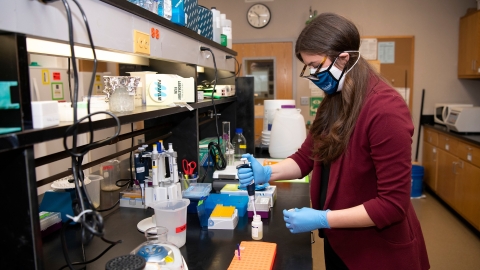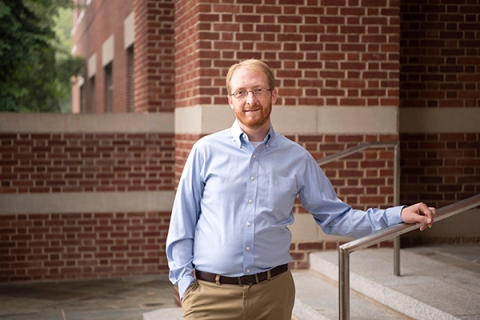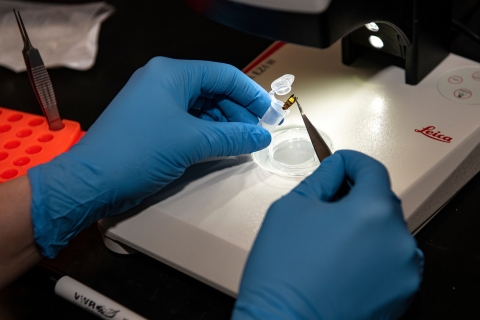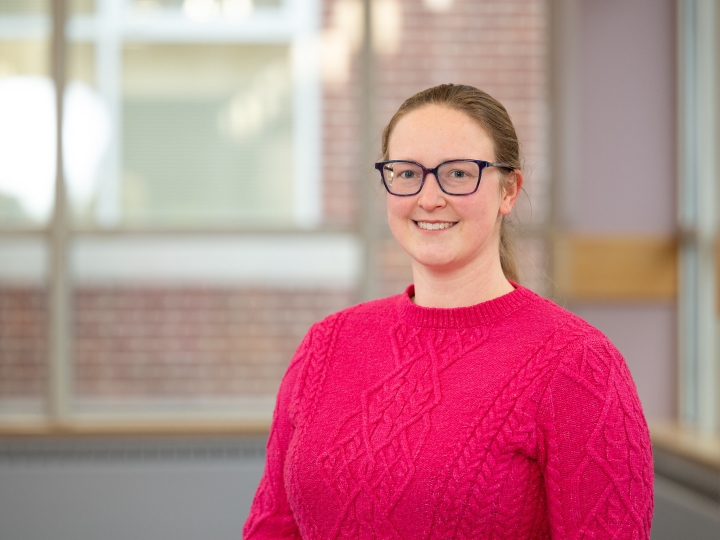
Bucknell’s Lower, Collins Awarded NSF Grant to Study ‘Dark’ Fireflies
April 19, 2021
Professor Sarah Lower, biology, works in her firefly research lab. Photo by Emily Paine, Communications
Whether they're called lightning bugs, glowworms or 100 other names, fireflies are best known for the light they flash at night to find and locate their mates. But not all insects in the firefly family bring a light show to their courting ritual. Some have lost the ability to produce light as adults and may instead use pheromones to mate during the day.

Professor Doug Collins, chemistry. Photo by Emily Paine, Communications
These "dark" fireflies will be the focus of a new research collaboration between Bucknell University Professors Sarah Lower, biology, and Doug Collins, chemistry, who were awarded last month a new $642,000 National Science Foundation grant for the five-year study.
The researchers will compare North American firefly species that use light versus pheromone signals in seeking and finding mates. Through their analysis, they hope to identify common patterns in the chemical, genetic and behavioral changes associated with the two forms of mating communication. Their research will dramatically expand the genomic data available on fireflies, enabling substantial advances in conservation studies. Lower previously published one of the most complete genomes for a firefly in conjunction with another research project.
"There are many species that have lost that ability to bioluminesce as adults that are known as dark fireflies. Instead of coming out at night, they come out during the daytime," says Lower, a firefly researcher who was recently featured for her work on femme fatale fireflies in the BBC program Chris Packham's Animal Einsteins. "For a nocturnal species, that light is really important as a mating signal, but if you're a day-active dark firefly, you don't have the benefit of light. Instead, we think that they're using chemicals or pheromones and smell to communicate."

Lower conducts analysis on a firefly. Photo by Emily Paine, Communications
That's where Collins comes in. He plans to figure out which chemicals are being emitted by the dark fireflies as pheromones.
"We think that these dark fireflies emit gaseous chemicals that are used as pheromones. My research group is going to try to identify those gases, which is actually a very tough thing to do," Collins says. "One of those reasons is that we'll be trying to analyze these chemicals at very low concentrations."
Collins and his research team also plans to analyze a waxy, sticky film that’s secreted by the fireflies on their backs.
"We're going to take very small samples of that material without hurting them and find out if we can distinguish different species by the chemical signature on their backs," he says. "The reason that's significant is because they also use that waxy coating for communication, it seems, and when they get in close contact, they use their antennae or other parts of their body to detect the chemical mixture in that waxy film."
Collins adds that his lab is well equipped to measure gases and organic films, enabling the researchers to hit the ground running.
Some of the grant funding will also be used to acquire new equipment for chemical analysis. A large portion will also support large-scale genomic analysis of both lighted and dark fireflies.
"We want to compare the genomes of these different species to see what’s different," Lower says. "We're expecting to see that fireflies that use chemicals and pheromones to communicate might have more genes that are involved in receiving and detecting chemicals in the environment."
That genomic data and the other findings of the research projects will give firefly researchers and conservationists a better understanding of firefly populations. According to Lower, it's difficult to quantify firefly abundance because some species are only active for 2 to 4 weeks per year. But by using the pheromones identified in the study, she says the researchers can design an apparatus that surveys population abundance.
The researchers are already catching fireflies and extracting their genetic material on campus. They'll next move to analyzing the genetic data on campus as well.
The grant also offers substantial funding for summer student research and to engage in scientific outreach activities in collaboration with Ibiyinka Alao, United Nations Ambassador for the Arts, both at Bucknell and the Pennsylvania Firefly Festival in the Allegheny National Forest.

